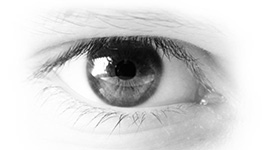Color Vision Deficiency in Black and White
Did you know that as many as 1 in 12 males are color vision deficient, with most not being able to distinguish red from green? For anyone with “normal” color vision, this is hard to imagine. Color vision deficiency, often referred to as color blindness, is the inability to differentiate certain shades of color, such as red and green or blue and yellow. In very rare cases, no color is perceived – only black, white, and shades of gray.
Roughly 8 percent of men in the world are affected by color deficiency, and only 0.5 percent, or 1 in 200, of women. Ironically, this condition is usually inherited at birth from mothers’ genes – mainly to their sons.
Like Mother, Like Son
While color vision deficiency can develop later in life through disease, injury, or certain medications, it is typically inherited through genes at birth. The most popular form of color vision deficiency, often referred to as red-green color blindness, is passed down through a sex chromosome called the X chromosome. Males have X and Y chromosomes (XY) – the X chromosome is from their mother and the Y chromosome is from their father. A male is born red-green color deficient if this one X chromosome inherits the “color deficiency” gene from his mother.
Females have two X chromosomes (XX) – one X chromosome is from their mother and one X chromosome is from their father. This makes it less common for females to be born red-green color deficient because both X chromosomes must inherit the ” color deficiency” gene (one from each parent). If only one of these X chromosomes has the gene, she is not color vision deficient but can still pass this down to her children at birth.
On the other hand, blue-yellow color vision deficiency does not occur because of X chromosomes. Instead, this form of color deficiency usually occurs because of a mutation in one of the human body’s non-sex genes or damage to the retina, causing men and women to be affected equally.
How Does a Person with Color Vision Deficiency See?
Cones within the retina of the human eye play an integral role in color perception because of their sensitivity to color. Every moment we are awake and wide eyed, these cones are sending messages to our brain to translate what color we are seeing in front of us. There are three kinds of cone cells, each sensitive to different wavelengths of light – red, green, and blue – that enable people to perceive a spectrum of colors. For example, when the red and blue cones are stimulated, purple is perceived. When one of these cones doesn’t function properly, however, color appears much differently.
In mild forms of color vision deficiency, one or more of the three retina cones do not function properly. In more severe cases, one or more of the cones do not function at all. While color vision deficiency is very complex, there are three general categories of this condition:
- Red-Green Color Deficiency: Making up approximately 99 percent of those with color vision deficiency, this most common form generally makes it difficult for a person to distinguish shades of red, green, brown, orange, and yellow, as well as blue and purple hues.
- Blue-Yellow Color Deficiency: Affecting roughly 1 in 10,000 people, this less common form makes it difficult to distinguish shades of blue, yellow, green, violet, and red.
- Total Color Blindness: The most severe and rare form of color deficiency, total color blindness refers to when a person cannot perceive color at all. Affecting approximately 1 in 33,000, their world is seen in grayscale – only black, white, and shades of gray.
Color vision deficiency is a chronic condition that can make life more difficult. In manufacturing and research environments where color is critical to an application or product, color measurement instruments remove all subjectivity by precisely evaluating, quantifying, and communicating the color of an object.
Can you see the number in the circle below?












